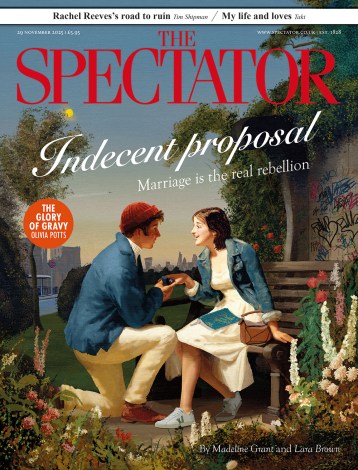In June 1933, the 24-year-old Martha Dodd, the daughter of the newly appointed American ambassador to Berlin, arrived in the German capital with her parents and older brother. She knew little and cared less about politics. To her, Adolf Hitler, who had just seized supreme power in Germany, was merely ‘a clown who looked like Charlie Chaplin’.
To all her friends in Berlin, Martha would show odd bits of information from her father’s office
The Berlin in which the Dodds found themselves was a ferment of intrigue, uncertainty, plots, counterplots, sudden disappearances and febrile gaiety. Three months earlier, the Reichstag had burned down and a state of emergency had been declared, which Hitler, as chancellor, then used to justify the imprisonment or execution of opponents, unleashing his brownshirts to harass Jews and generally enforce a dictatorship. Around him members of the Nazi party jockeyed for position, plotting against each other, torturing those suspected of withholding information and subverting democratic institutions.
It is sometimes difficult to disentangle the story of Martha – the ‘traitor’ of the title – from Brendan McNally’s mass of complex background material, filled with minor characters, subsidiary plots and political dramas. What emerges clearly, though, is that the American ambassador who stepped into this maelstrom was possibly the most unsuitable person who could possibly have been found for that prestigious post. A patriotic farmer’s son who believed in the simple life, William Dodd refused to live in the embassy because it was too grand; he slashed the entertainment budget, substituted his son as embassy chauffeur and regarded the lifestyle of his staff, many of whom were wealthy, as a ‘betrayal of American egalitarianism’. He soon became an object of ridicule; but far worse, rather than listening to his able and experienced aides, he turned to his family for counsel, in particular his daughter, giving her the run of his desk.
For Martha, Berlin’s social life was exhilarating, with its balls, dinners and receptions. Pretty, vivacious and promiscuous, she soon had a string of lovers, many of them handsome young Nazis, and thanks to her previous job on the Chicago Tribune, she got to know Berlin’s 30-odd American correspondents. To all these friends she would often show odd bits of information from her father’s office. Though the embassy staff knew nothing of this, they were alarmed at her closeness to leading Nazis. She was even trotted out as a potential bride for Hitler, although the meeting came to nothing: ‘He seemed modest, middle class, rather dull and self-conscious,’ she wrote later. ‘It was hard to believe that this man was one of the most powerful in Europe.’ Instead, by that autumn, she had three regular lovers.
Martha’s original enthusiasm for the Nazi party soon waned. When she, her brother and a reporter friend took a trip through the surrounding countryside, to be greeted everywhere by smiling, well-fed villagers, they were suddenly faced with the horrors that underlay this political creed when a parade of stormtroopers, accompanied by a brass band, dragged a terrified, half-naked woman through the street, to be spat on and reviled ‘to teach her a lesson’. Her crime? She had a Jewish fiancé.
Then came a coup de foudre for Martha. Boris Vinogradov, a young Soviet diplomat, was tall, slim and blond, with deep, soulful blue eyes and a polished manner. Their tempestuous relationship, with flagrant infidelity on both sides, was to shape Martha’s future. Like many others, she had begun to feel that communism was the only way to fight the fascist brutality that was becoming daily more apparent. Deeply in love with Boris and increasingly under his influence, she began slipping him reports and cables from her father’s desk; and when he urged her to commit herself fully, she booked a package tour to Russia, ostensibly to see the country but in reality to tell whatever influential Russians she met that she would ‘work with them’.
The affair with Boris continued until the Dodd family left Germany for the US in 1937. Soon afterwards, Martha married the 40-year-old millionaire Alfred Kauffman Stern (Boris was shot in Stalin’s great purge of 1938 as ‘an enemy of the people’). Stern enthusiastically joined Martha in the espionage work for the Soviets she was carrying on through various handlers and a network of communist sympathisers.
By now the FBI were watching, and by the end of 1948 had collected enough information for the unmasking of several society spies. When the Sterns read a gossip column saying that an ambassador’s daughter would soon be subpoenaed by the McCarthy Committee, it was all the warning they needed, and they fled to Mexico. But in 1957, after several successful spy trials, the FBI subpoenaed the Sterns and suddenly Mexico seemed too close to America for comfort. Thanks to their Soviet contacts, they were able to take refuge in Prague, where they lived out the rest of their lives.
What is perhaps most extraordinary about this story is that the devoted daughter of someone dedicated to serving his country should herself be equally dedicated to betraying it, especially while enjoying all it had to offer. When McNally, during his six years reporting from Prague, met Dora, Martha’s former secretary, he asked what she remembered about her employer. ‘She was a bitch,’ replied Dora succinctly. On the evidence, it is hard to disagree.







Comments